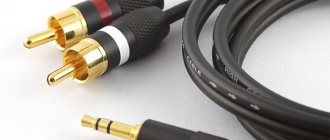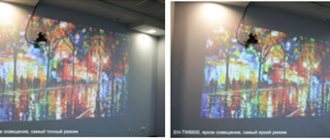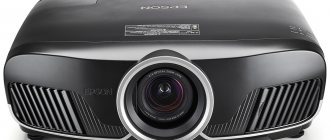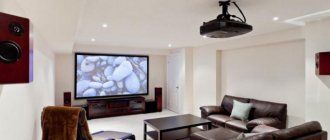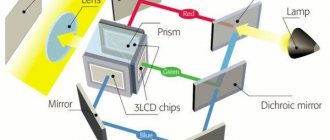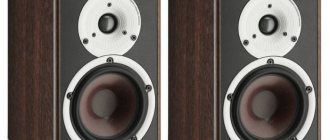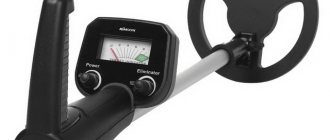A post about how I learned Zen and began to have a new attitude towards budget projectors.
Speaking about a real Home Cinema (that’s right, with a capital “H”)
, we usually imagine a comprehensive solution, including interior design, acoustic preparation of the room, and installation of a multi-channel sound system. Well, the “cherry on the cake” is a cool projector such as the Epson EH-TW9400, because it is the projectors of the nine thousandth series that year after year show themselves excellently when compared even with noticeably more expensive top-level models, and have gained the reputation of “affordable High End”.
But what happens if you compare these “celestials” side by side with the most budget home projector in the Epson line
?
For the very interesting results of my personal comparison of two such devices, please see cat.
Why and which projectors were compared?
The very idea of such a comparison seems to be a little “against the rules”, because projectors have completely different “weight categories”. And in general, which brand’s blog will you read about how, instead of a “fat” flagship, it makes sense to look towards a much more budget-friendly one, such as, for example, the Epson EH-TW650 (blog post)?
However, I don’t see anything “unnatural” in testing the assumption that for less money you can get a completely sensible device at your disposal. And you shouldn’t underestimate, or even deliberately belittle, the capabilities of entry-level projectors.
In comparison, models such as the Epson EH-TW5650 (blog post) and Epson EH-TW7100 (blog post) will also be mentioned here and there. However, I did not focus on them, because everything has already been described in the corresponding blog posts about them, and it is much more interesting to compare the “two extremes”.
The comparison was carried out in the Pult.ru demo zone, which has a cool darkened cinema room with a 260 cm wide screen. The screen diagonal is 117 inches, the surface is matte, with perforations for acoustic transparency. This diagonal allows you to achieve an excellent immersive effect, but is noticeably more demanding on the brightness of the projector than such popular options as 80 and 100 inches.
In total, the following people took part in testing:
- The flagship Epson EH-TW9400 costs around 2700 USD;
- "State employee" Epson EH-TW650 priced at ~$600.
Pros and cons of a projector in front of the TV
Creating a home theater is a difficult and controversial task. This manifests itself in the choice between a projector and a TV. Let's finally discuss what you are reading this article for - is a projector really better than a TV? Or are these fables from those who bought such a device? Go ahead and figure it out!
Dimensions
One of the most dominant and noticeable areas that distinguishes a projector from a TV. It manifests itself in the size of the devices. And to be more precise, in price. To purchase a TV with a diagonal of, for example, 80 inches, you will have to pay a lot. While the projector broadcasts the image over several meters. Despite the fact that its price is noticeably lower - 2 or even 3 times. The quality is no worse than on widescreen TV. But in some cases, you will still have to spend money: not everyone at home has a perfectly flat wall where the beam from the projector lamp could fall. Therefore, you will have to buy a special canvas that hangs on the wall.
Brightness
The quality of the canvas depends on this element. It changes based on the illumination of the specific room in which the projector is installed. Accordingly, in a bright room, the brightness should be high to provide a rich picture. But such a device will cost significantly more.
If you look at situations from the other side, looking for solutions rather than creating problems, then the windows can be covered with dark curtains and blinds to ensure the maximum darkness possible. This leads to another principle - the darker the room, the less brightness the projector needs. Also, the projector causes less strain on the eyes than the TV display.
Contrast
Here, of course, TV dominates. Since its brightness and contrast can be adjusted in the menu, unlike a projector, where these are basic settings that cannot be changed.
Image clarity
You know that 4K TVs are no longer a luxury? This created considerable competition for projectors. In such TV, the eyes receive maximum pleasure. Analogue TV is not inferior in quality, but inferior in price. Buying a high-resolution projector will be expensive. And it is impossible to force it to improve the quality of the output image. But partly, this is where their advantage lies. They have enough image quality to be delighted with the quality on the canvas.
Color rendering
The color rendering of the projectors is all right, at least in terms of the price component. You can see good colors on the screen for little money. TV cannot boast of this, since to increase this indicator, precise processor processing is needed, which directly adjusts the price tag. Naturally, expensive 4K TVs have a much higher color gamut spectrum than similarly priced projectors.
Installation
Here the situation is a little ambiguous. The advantages of TV in this aspect are significant. You just need to put it on the TV table, connect the cables and that’s it, you can enjoy watching. Even hanging it on the wall is not such a difficult task, for which it is not necessary to invite specialists. What can't be said about the projector...
First, you need to find the ideal place for the submitted image. The fact is that if you decide not to purchase a special screen sheet, you will have to find the smoothest wall available in the house. Why such principle? Imagine, the wall is uneven, the beam falling on it will flow around the flaw, which will make the integrity of the picture not entirely pleasant. In addition, positioning the projector is not very easy. One thing that saves you is that manufacturers equip their models with a mount for hanging on a ceiling or wall.
The whole thing needs to be connected with wires. You will need an HDMI cable or a wireless sensor, which is not cheap. If you plan to connect more than one device, get ready to purchase a video switch, which carries another cable. While the TV is famous for its ease of installation.
But there is salvation. Now a new model of projectors is gaining popularity - short throw ones. Their beauty is that you can place them right in front of the canvas without having to worry about finding a place to install them.
Sound quality
TVs are initially produced with built-in speakers, which (depending on the TV itself) fully satisfy the need for high-quality sound. Some projectors are also equipped with speakers, but to be honest, they are of little use. In addition, the projector is most often mounted on the ceiling, which reduces the audio stream to zero.
Of course, to watch TV channels, the built-in speakers from the TV will be enough, but to get home theater sound, you will need additional equipment. Therefore, it is impossible to say unequivocally that the TV is the winner, since the sound coming out from the speakers it has is mediocre. And this is not the target task of the TV.
Ease of use
You won’t be able to lie at this point - TVs clearly win. You don’t need a special dark room for a high-quality image, no replacement of lamps.
Thanks to the development of the Internet, Smart TVs have support for many streaming services.
Image and color quality
"State Employee" Epson EH-TW650 and 117-inch diagonal image
I’ll say right away that all the projectors under consideration could easily cope with such a diagonal, even in the maximum color accuracy mode, because have a luminous flux of 2500 to 3000 lm.
However, there is a nuance: models with HDR support (Epson EH-TW7100 and EH-TW9400) have a slightly more powerful lamp - 250 watts versus 200-210 watts for entry-level projectors, which is logical, because HDR projectors need to have the power to produce turbocharged brightness in scenes with a wide dynamic range. And in accurate color mode, you should expect some reduction in luminous flux from all projectors (regardless of brand).
At the same time, with any projector chosen for testing, we in any case get a large, bright and colorful image (this is not some kind of “old-fashioned” slide projector). In addition, it seems to me that without the installation of side-by-side projectors, most viewers would not be able to immediately determine which image was being shown at the moment upon entering the room, since for this to happen the image would have to contain noticeable, conspicuous inaccuracies or even “defects.” " And here they are not
.
Epson EH-TW650:
Epson EH-TW9400:
I must admit that the screenshots did not allow us to convey the difference visible to the eye, primarily in contrast and black depth (the images were not color corrected, and I do not want to “fake” them).
I will also note that I enjoyed looking at all the projectors in the high lamp power mode, where I, however, immediately noticed a more audible operation of the cooling system of the entry-level projector in this mode.
Picture quality on TV and projector
But it's not just the screen size that matters. Image quality also matters. And here the projector loses to the TV screen in all respects.
Even in a completely dark room, the projected “picture” will be too “white”. However, you see it yourself in the cinema. Black that looks gray is one of the most important problems. The fact is that the matrix of this device is, in principle, transparent, and behind it there is a powerful lamp. It is impossible to achieve high contrast in such conditions.
Projecting a “picture” also “eats” the colors. The image looks dull and lacks richness of color. All these bright colors are “thought out” by the brain, trying to “fit” the picture into something familiar.
It is impossible to achieve absolute white, no matter how sad it is. The matrix is transparent, but has a distinct grayish tint due to the layer of current-carrying conductors. And this also leads to a decrease in the saturation of colors, including white.
A television screen with its reflective layer behind a panel of image-forming LEDs is essentially free of these shortcomings. Its color, contrast and shade saturation are very high.
So in the battle for image quality, the TV definitely wins.
However!
There is a special type of projector - laser. They use a unique image projection technology that ensures high quality. Laser projectors are similar in brightness, saturation and contrast to a television screen.
Laser projectors only have a couple of problems. Firstly, they are quite rare on the market. Secondly, they are simply expensive - even a model from Xiaomi, which is sold in the “mid-budget” price segment, costs about 2 thousand dollars. For this money it is quite possible to buy a large and beautiful TV.
Color accuracy and color gamut
Anticipating how you shake your head, looking at the two pictures above that don’t say much, I’ll say a few words about the results of an “objective” assessment of the color rendition of the considered models using instruments. I tried to keep it brief, but if you don’t want to delve into the details, just skip this paragraph.
The standard is the “HD standard” Rec.709, and the deviation from the standard is measured in special units (Delta E, CIE94). Every home projector must have a color mode “tailored” to the standard. For the Epson EH-TW650 it is called “Game”, and for the rest of the participants, including the Epson EH-TW9400, it is called “Neutral”.
A color is considered accurate if Delta E is less than 3.
Color charts allow you to visualize the accuracy of individual colors
As a result of measuring 100 colors, I obtained interesting results: the average error for both models was in the range from 2 to 3. Of course, the Epson EH-TW9400 was initially the most accurate (cf. Delta E = 2.26), and it is better suited than others for professional calibration, allowing the error to be reduced to negligible levels. However, the result of the Epson EH-TW650 was also very good:
average Delta E = only 2.49!
Yes, it has its own “innate” weaknesses associated with blue and 100% green, but you can’t argue with the numbers - on average, color accuracy is exceptionally high, and in most cases the Epson EH-TW650 should not differ much from the Epson EH- TW9400 in terms of
color accuracy
We’ve sorted out the measurements, but there’s still no escape from comparisons based on subjective sensations, that is, when viewing real content with your own (in this case, my) eyes.
Resolution: 1080p or 4K/HDR?
In this comparison, I rate a budget projector for the "average" person who needs a workhorse for viewing a wide variety of content. Those. Full HD resolution is quite enough. Yes, of course, flagship models like the EH-TW9400 have 4K Enhancement technology for outputting 4K content on a 1080p matrix and leveling the pixel grid. But to be honest: on a 117-inch screen, from a distance of more than one and a half meters, the grid of pixels in a 1920x1080 picture cannot be seen. And why then overpay?
I was also curious to see how a top projector would cope with “regular content”, which included various demo videos and film fragments, with different bitrates, incl. on YouTube, because the owner of even the most expensive device will not watch exclusively 4K HDR BluRay releases on it, right? If we take an analogy with cars, then I look at the behavior of an “elite foreign car” on “domestic roads”.
As I already said, the feeling of “naturalness” of the image on the Epson EH-TW9400 consists of many factors. This “naturalness” affects the perception of the most ordinary scenes, which become interesting precisely because they are perceived “as they should.” What do you think of these arguments?
Here, for lack of anything better, a word comes to mind that is often used by Western projector reviewers - image “clarity”.
As with most things, the photographs don't do justice to the most significant differences between the two projectors.
Epson EH-TW650:
Epson EH-TW9400:
For example, the strength of the Epson EH-TW650 is the quality of rendering smooth color transitions and halftones, which perfectly complements the good accuracy of color shades and the richness of colors. However, flying over the snowy mountains turned out to be a difficult test for this model, because you have to look at “ordinary” shades of white.
At the same time, in the “Cinema” mode, the Epson EH-TW9400 makes even this scene more dynamic and impressive. And this despite the fact that the video is saved in SDR, not HDR! When rendering leaves and flowers swaying in the wind, the Epson EH-TW9400 gives a sense of presence and “hyperrealism” (hello, Michael Bay!)
, whereas on the Epson EH-TW650 these scenes looked somehow too “formal”... Like on a monitor screen. However, there were also numerous scenes that this projector quite successfully filled with life, although, of course, without much chance of catching up with the Epson EH-TW9400, which “can” handle the DCI color space and generally supports HDR.
Projectors - customer reviews
Advantages:
My review of the Xiaomi Mijia Projector (Chinese version). First, about the pros: 1. I liked the design of this projector - it looks very modern. Compact, does not take up much space, you can take it with you. Very light. 2. The sound of the projector is simply bomb, I did not expect such high-quality sound from such a small device as from jbl speakers. I didn’t even bother attaching external acoustics to it. Although it was possible to connect it to my amplifier via Bluetooth. 3. There is Android on board and Wi-Fi. It works over the air, does not stall, and is updated. 4. The short-throw projector is a plus for some, but a minus for others. From 3.10 meters it gave me a diagonal of 114 inches. 5. The projector has good colors, the image it transmits is more similar to a TV than is acceptable from Chinese projectors using 1 LCD technology, there is a cinematic picture effect, but this projector does not have it. The colors are cool, bright, the blue sticks out a little, but everything can be adjusted. 6. Not noisy. Well protected from dust penetration. The lens is protected by glass, so you can wipe it with microfiber or an optics cloth. 7. Does not heat up, does not heat the room like lamp ones)
Flaws:
There are also disadvantages, to be sure: 1. The biggest disadvantage is the lack of global firmware. There is only English, all services are Chinese. Exit: just go to 4pda, read the forum, then reflash it like a TV from xiomi. Then there will be Russian language and Chinese services will not be an eyesore on the main screen. In general, I did not expect such laziness from xiomi. 2. A huge plug with a block is not our standard, so everything has to be connected via an adapter, why it couldn’t be done like in laptops (wire - block - again a wire with a plug, remains a mystery). The bandura does not fit into the wall socket, I had to use an extension cord). 3. Black color is not quite black, but dark gray. Moreover, greenish ants (artifacts) run on black. I can see them from a meter away with poor eyesight, but those with good eyesight can probably still see them (they really infuriate). 4. A colorless frame of 3 cm around the entire perimeter of the screen on which there is no projection. Therefore, I recommend a screen with black fields. This is a minus of DLP technology. 5. There is no zoom to reduce the picture (a very big minus). You just have to move the projector. And I wanted to hang it permanently. For me, the diagonal is too large from 3 meters, it’s hard to look at 114 inches, since 85 inches are behind the eyes. And your vision will deteriorate if you look at a very large diagonal at close range. 6. Automatic correction does not always work correctly, but there is no horizontal correction (that is, it cannot be placed on the side like z6 is acceptable). 7. DLP technology is a minus for me; if you look at the projection with your phone’s camera, you will see the picture flickering (like shim on monitors). My eyes were tired. 8. Not fair 1080p with pixel shift (like pixel shift). It’s not particularly clear, of course, that it’s not fair unless you compare it head-to-head with another projector. 9. Automatic focusing that loses focus when the device is not warmed up. You turn it on, watch it for 15 minutes, then the focus is lost, you set it up again and then the focus is not lost.
In general, the projector left a pleasant impression. In terms of color rendering, it compares favorably with popular models on 1 lcd (26k, m18, m19, 1080p). But in terms of lumens it is not much ahead of them, it is a little brighter. Black is worse. 500 ANSI lumens is not that much. More than 120 inches will not achieve normal brightness. If your eyes and head don't hurt from DLP technology then I recommend this projector.
Contrast
Now, finally, let's talk about contrast (after all, the Epson EH-TW9400 has 10 or more times higher “according to the passport”).
A little hint for those who don’t know about the Epson line:
- the first “qualitative leap” in native contrast occurs on the Epson EH-TW5650 model (it is significantly higher than that of the EH-TW5600, see blog post on the topic);
- the second is for the Epson EH-TW7100 projector (including in comparison with the EH-TW7000). However, the EH-TW9400 has the most impressive contrast gap over all previous models.
In general, in fact, I’m comparing the projector with the smallest and largest
contrast!
But how exactly does high contrast affect when viewing real content
?
A review showed that, oddly enough, the depth of black color itself is not the main difference. Given the overall accuracy of the picture (without strange shades in transitions, “dips” in shadows, etc.), even a relatively elevated black level is not annoying. Although, of course, dark scenes are an important measure of the “class” of a projector. But this is not the main thing. First of all, high contrast gives light, bright scenes a greater “naturalness”, a greater sense of realism, depth and volume. Combined with high brightness, all this makes the Epson EH-TW9400 an enviable HDR projector. Accuracy combined with deep blacks allows you to achieve spectacular and “life-like” images even within the limitations of good old HD/SDR content with average bitrates.
On dark scenes, the devil is also in the details. Personally, one scene in “The Dark Knight” caught my eye: a commando runs down the stairs in complete darkness, and the light of a flashlight glides across his face. The Epson EH-TW650 can accurately convey many scenes where there is shadow and bright light at the same time, but not this one! Here, the Epson EH-TW9400 really helps highlight facial features in that small highlighted area without overexposing them or losing detail. And this is not something sensational - just an ordinary flashlight in the dark.
Epson EH-TW650:
Epson EH-TW9400:
Another scene.
Epson EH-TW650:
Epson EH-TW9400:
The raised black level of one of the projectors is clearly visible, like the notorious “glow” of IPS matrices (the images have not been color corrected). At the same time, the Epson EH-TW9400 actually does not have such loss of detail in dark shades as in the photo. It’s just that the difference in brightness when moving from bright to dark areas is so strong that the picture from this device “did not fit” into the dynamic range of the camera. More precisely, it fit, but only inside a 14-bit RAW file. I could restore these details by re-developing the file in the editor, but then the comparison would no longer be fair. That’s why we compare sRGB JPGs vs JPGs everywhere, where each has around ~7 “stops” of dynamic range.
Let me make an important note:
when switching from Epson EH-TW9400 to Epson EH-TW650, gradual adaptation occurs,
and after half an hour the dissatisfaction with the decrease in the overall image level disappears.
Oddly enough, black color ceases to be a “problem”: you quickly get used to the black level, but you still feel a certain general loss of realism after the picture from the 9400.
Projector screen size compared to a 65-inch TV
Let's look at the screen area ratio of a 65-inch television image to a 100-inch projector image. The 65-inch screen is 56.65 inches wide and 31.87 inches tall, with an area of 1805.34 inches². The 100-inch projector image is 87.2 inches wide and 49.05 inches high, giving an area of 4273.00 inches².
Read: DLP projector what is it? How to choose and which one to buy?
Even though the difference in diagonal size is only about 1.5 (100/65 = 1.54), the difference in area of the two images is 2.37 (4273/1805 = 2.37). So you get a projector image that is almost 2.5 times larger than a large 65-inch TV. TVs larger than 65 inches are very expensive, much more expensive than a high-quality projector.
Read: LCD projector what is this? How to choose and which one to buy?
The quality of a 100-inch picture from a good quality projector is excellent, and when viewed alongside the best quality TV picture on a 65-inch or even larger TV, you will definitely choose the projector. The downside of the projector is that you have to watch the projector in a room that is always darkened.
Read: LCoS projector, what is it and is it worth buying?
While the room is dark, the projector's image will have much better quality, such as a higher contrast ratio, greater image clarity overall, and the feeling of being in a real movie theater. Projector images are easier on the eyes and cause less eye strain than bright images on a TV screen.
Other features and differences
In addition to image quality, it makes sense to pay attention to other parameters of projectors. For example, in the testing room, the Epson EH-TW9400 sat on a shelf behind the audience, while the Epson EH-TW650 has a shorter throw lens and was conveniently placed on a table in front of the audience. The Epson EH-TW650 was easy to set up, lightweight and compact, but the Epson EH-TW9400 felt even easier to set up thanks to its noticeably larger lens shift and zoom range.
As I mentioned above, if the viewer so desires, the Epson EH-TW9400 is able to neatly “beautify” the image by expanding the color gamut from REC.709/sRGB to DCI - in some cases this will further improve the overall image quality. The Epson EH-TW9400 also has an additional aperture for fine-tuning maximum brightness, while the Epson EH-TW650 does not have 3D support (it has been present since the Epson EH-TW5600 series).
